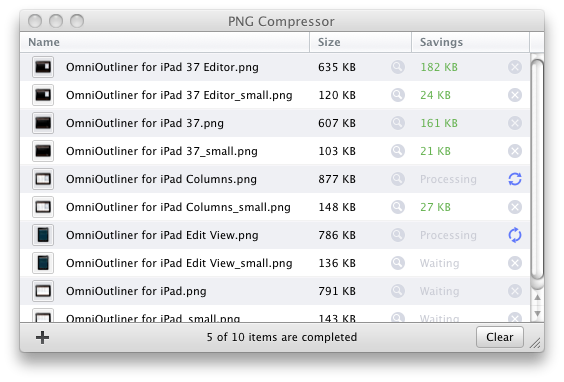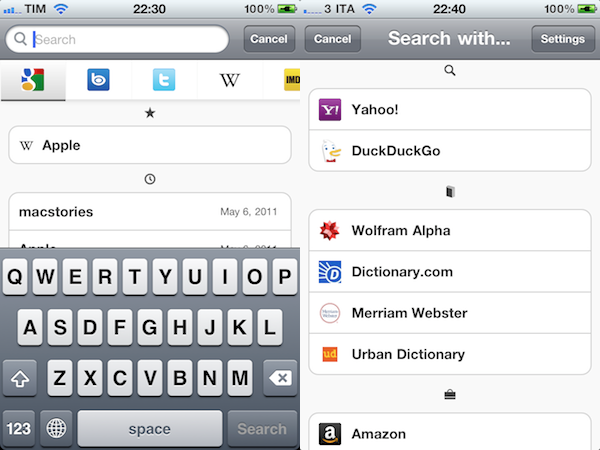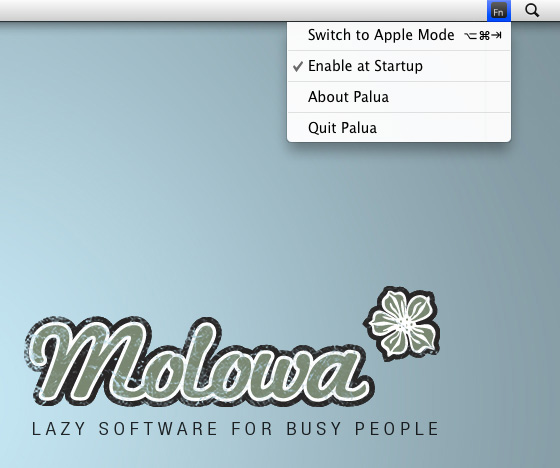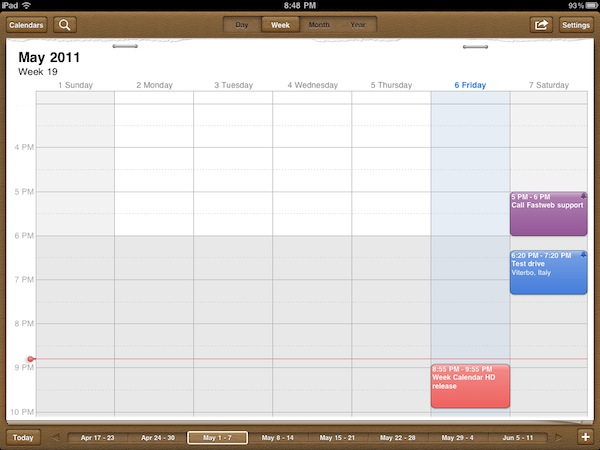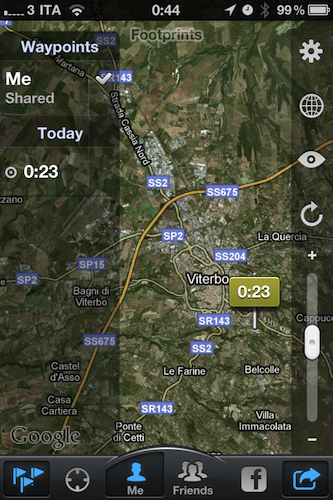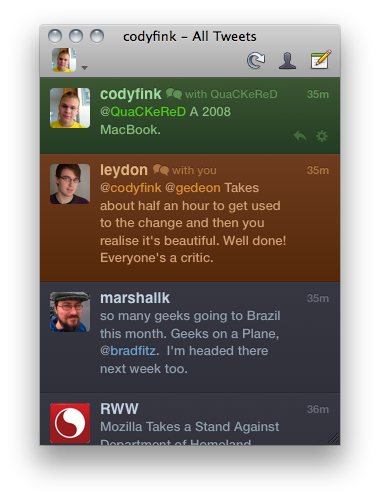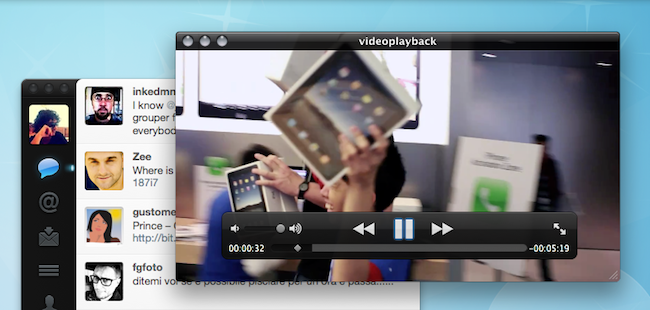Most of the time (not all of the time), I run my iPod and iPad screenshots through an optimizer before tossing them onto the web. Usually I do this via a script I’ve set up with LaunchBar, but I wanted to take the extra step of running that command after dragging-and-dropping to just the dragging part. If you’re looking for lossless PNG compression in a simple utility, PNG Compressor for the Mac is a utility designed for quickly dragging a folder or group of images into the icon or onto the window for seamless, instant compression. As a wrapper for optiPNG (with support for Pngcrush and AdvPNG coming soon), PNG Compressor is a classy way to reduce the file size of your images before uploading to the web. Currently on sale for $0.99 in the Mac App Store, a quick buck gets you a gorgeous icon and a useful utility.
Posts in reviews
PNG Compressor for Mac Optimizes Your Images for Web
Search Ninja Gives Your iPhone A Better Web Search
If you’re familiar with Swearch, a neat iPhone web app that allows you to search for a specific query on multiple websites at once, then you’re most definitely going to be interested in Search Ninja, a $0.99 app that allows you to flick through search engines, star search results, and start typing in seconds to find exactly what you’re looking for. Search Ninja’s concept is simple, but the execution is powerful in the way it meets a user’s expectations when it comes to mobile search. Upon opening the app, you’re immediately greeted with a Google search field, and the iOS keyboard ready to type. No need to tap on buttons to start searching, no need to do anything before performing a regular Google Search. If you, however, want to customize the search experience and have those extra seconds to make sure you’re navigating to the right webpages, Search Ninja features an intuitive swipe interface to switch between search engines in seconds. Both on the main screen and in the embedded web view, you can swipe to change from Google to Bing, Twitter, Wikipedia, IMDB, Youtube, Flickr and many, many more. You can even add other engines if you really feel like your favorite one is missing, although the process requires a 2-step wizard screen.
Two features I particularly appreciate about Search Ninja are favorite searches and the History section. They’re very straightforward, but come in handy if you find yourself looking for the same things on your iPhone over and over, or simply want to look up an old subject again.
Search Ninja strikes me for its simplicity and clean design. Gestures to switch engines are a plus, and a very useful one. Get the app here at $0.99.
Carousel Is A Beautiful Instagram Client for Mac
Back in April we covered Instadesk, the first Instagram client for Mac that, through an interface design similar to iTunes and iPhoto, allowed you to browse Instagram photos, users, likes and comments directly from your desktop. The app was one of the thousands of results coming from the launch of the Instagram API, a set of tools that enable third-party developers to plug into your Instagram feed to retrieve photos uploaded by you or relevant to you. Of all the Instagram-connected apps we’ve covered, Instadesk saw a huge success as it was the first one to land on the Mac App Store.
Carousel, however, wants to step the game up by offering a beautiful and slick way to access Instagram from your Mac with a design that’s heavily inspired by iOS, yet runs natively on OS X. I don’t know if the developers are using the Iconfactory’s Chameleon framework for this, but it certainly looks like Carousel has some similarities with Twitterrific – the Twitter client from the Iconfactory that shares it codebase across the Mac, iPhone and iPad. So what’s this all about? First off, Carousel presents a minimal, vertical-oriented interface as if you were looking at your iPhone’s screen in portrait mode while browsing Instagram. The photo stream is embedded directly into the app’s window, with beautiful Instagram photos to flick through as they load. At the bottom, three tabs allow you to switch between your feed, popular photos and your profile. Every photo can be enlarged via Quick Look, saved locally on your Mac, or commented / liked thanks to a wide selection of keyboard shortcuts to choose from.
In Carousel, you can open every user’s profile to check out their photos. You can comment and like pictures, too, with interaction happening inside an iOS-like popover that resembles Twitterrific’s implementation of conversation views and profiles. You can even view if a user’s following you, or if you’re following him. Last, the app can be themed. Carousel’s default theme is already gorgeous in my opinion, but you can switch to a classic Mac or red one from the Settings.
Carousel can be downloaded for free, or you can purchase a license at $4.99 (introductory price) from the developer’s website. More screenshots below. Read more
TouchUp for iPad Gracefully Adds Effects to your Photos: Review & Giveaway
The photographs you’ve dumped onto your iPad via the Camera Connection Kit are already pretty swell, but what if you had an app that took an ordinary shot and turned it into something seriously beautiful? With TouchUp by RogueSheep, you can quickly swipe over your photographs in an elegant and friendly interface that encourages creativity. Example photos are included to get you familiar with what’s possible with TouchUp, and we’ll be taking a look at one of these pre-included items to help you get started.
Palua for Mac Toggles Your Function Keys
Defaulting to a variety of Apple keys for media, Exposé, and the Dashboard, the functions keys have to be continually activated by holding down the Function (fn) key on your keyboard. Function keys by default offer some powerful functionality; F8 is used to activate Spaces or Yojimbo; the F9 through F11 keys manage windows; and applications such as Photoshop can make extensive use of this top row for various functions. If you are going to be making use of the functions while working in a specific app, Palua for Mac allows you to toggle the function keys on and off so you don’t have to mash the fn key with each command. More interested in getting use out of those function keys than changing the volume? From the menubar or a simple ⌥⌘⇥ (option-command-tab) keystroke, Palua will activate and deactivate the function keys as needed when working in various projects. Used in combination with Keyboard Maestro, you could create some pretty powerful workflows where apps automatically launch and the function keys are activated for immediate use. Palua is available on the Mac App Store for only 0.99 cents, which can be purchased and activated at login so you’ll always have the function keys readily available with a quick keyboard shortcut.
Week Calendar Comes To The iPad
When I first reviewed Week Calendar for iPhone in March, I called it a powerful alternative to Apple’s standard calendar app for iOS devices. It’s not that Apple’s Calendar.app lacks basic functionalities or is utterly broken: in fact, I think Calendar is more than fine for most users. But if you’re willing to get the most out of your MobileMe, Google Calendar, Exchange or CalDAV calendars, UtiliTap’s application is the full-featured alternative to install on an iPhone. And today, you’ll be able to enjoy Week Calendar on the iPad as well, thanks to an “HD” counterpart that’s just been approved and is now available at $2.99 in the App Store.
Week Calendar HD has all the features from the iPhone version, only on a bigger screen and with visual cues from Lion’s calendar app. The difference between the iPad’s native Calendar and Week Calendar HD is very subtle, but Week Calendar implements a leather background and bits of torn paper in a way that’s more reminiscent of Lion than Apple’s own app. Clearly some people are going to hate this choice if they were looking for a cleaner UI as seen on the iPhone, and perhaps the developers will revise their decision. I don’t know, but right now this is what you get. And, more importantly, what matters is that Week Calendar still outpaces Apple’s calendar solution when it comes down to views, gestures, copy & paste support or mere customization of the calendar. Week Calendar’s biggest advantage over Apple’s cal is support for multitouch with copy & paste, possibility to add a new event with tap & hold, easy resizing of events and pinch to personalize the selected view. You can tap and hold an existing event to move it around and change its start and end date; you can “cut” an event and paste it somewhere else; you can access an event’s info panel with a single tap, rather than having to tap the Edit button like in Apple’s calendar. Again, this works like the iPhone version but it’s been ported successfully to the iPad with the use of popovers and bigger real screen estate. From the Event Details panel, like on Week Cal for iPhone, you can set an alert, availability status, custom color, or find your away around four buttons that allow you to share an event, print it, email it or add it to the template list. Week Calendar, in fact, can turn any event into a template to use again in the future. Notes, invitees and local contacts can be attached to an event, too.
The selection of settings is equally impressive. You can turn on time zone support and specify when the week or weekend start, manage new events’ default preferences and the aforementioned templates (these will save you a lot of time), customize standard colors to assign a color by default to events that meet certain title criteria. There’s more: you can activate TextExpander integration (save even more time), turn off drag & drop entirely, completely overhaul the way the app displays days and weeks. For instance, you can change font sizes, enable out-of-view indicators, tell the app when a day starts and ends. Anything else is just Week Calendar for iPhone, running on the iPad with a new UI: lots of features, yet easy to use.
If you’re a calendar nerd, Week Calendar HD for iPad is a dream come true. It’s got all the customization options you’ve always wanted from the tablet’s calendar app, plus a design consistent with Apple’s recent standards and tons of gestures to simplify navigation. Get it here at $2.99.
Footprints Lets You Share Your Location, Track Your Friends and Family
With all the debates surrounding Apple’s use of location tracking data, it’s not surprise that apps based on the opposite concept have started showing up on the web and App Store: whilst the blogosphere made a big deal out of a software bug in iOS that left a cache of cellular points unencrypted on a computer, some people thought from the beginning of this latest Apple brouhaha that having visual access to your location in history, on a map was a cool thing. That’s why the NYT Lab department itself created a web tool to donate and visualize location data: if you have nothing to hide and you don’t mind sharing your location history, seeing stuff on a map is neat. Some even say it reminds us of the power of mobile technology nowadays. Footprints, a new app for iPhone and iPad, takes this idea a step further and allows you to constantly monitor the real-time location of your friends, family members and employees legally, with an app, all the time, with a few taps.
Footprints has got an interesting pricing scheme: it’s free for two months, but you can purchase a subscription for 3 months ($0.99), one year ($2.99) or two years ($4.99). If you download the app now, create an account and then purchase a three-month subscription, those three months will add on top of the two months you already have for free. Very cool. So how does it work? You basically can create an account to be tracked in real-time, and share your location with your friends and family. Similarly, people can share their location with you, choosing an expiration time for sharing and the maximum number of “waypoints” to display. Footprints relies on Apple’s GPS tracking implementation, and for this reason it comes with several settings to tweak the behavior of background tracking in order to make sure battery won’t die in 2 hours. The developers explain the app uses Apple’s “Significant Location Change” technology to determine location changes and waypoints, which are typically logged after a change “of 500 meters to 3 km or a quarter-mile to 2 miles”, depending on cellular network coverage. In the Settings, however, you can customize the location tracking method even deeper: if you don’t want to use cellular triangulation, you can turn on GPS pulse every 10 minutes, or every 5 minutes. Of course, the more frequently a GPS call occurs, the faster your battery will drain. But there’s more: you can specify a “sufficient accuracy” in locating your position, auto-sensing and “minimum movement.”
The app’s got Facebook check-in integration and parental controls with passcode, but what struck me as incredibly easy is the way you can share your location with people you know and trust. In the settings, all you have to do is pick a contact from your Address Book, and choose to share your location with him / her. Provided this person is using Footprints with the same phone number and email address you have in your Address Book, he or she will be able to see your position based on the sharing settings you chose. In the main screen of the app (a map), you’ll be able to switch between your location (marked by a Me tab) and others’ (the Friends tab). That’s it. As these people move and go places, you’ll see them on your device with the waypoints and information they chose to share. It’s remarkably user-friendly, private, and, overall, simply well done.
Footprints is free, features iTunes in-app purchases and adopts the “it just works” philosophy for two important subjects nowadays like location tracking and privacy. Give it a try.
Twitterrific for Mac 4.1: Autocomplete, Visual Tweaks, and Better than Ever
If you’re a proud user of The Iconfactory’s Twitterrific (Hooah!), it’s time to check the Mac App Store or the menubar for an update to 4.1, which brings lots of new & thoughtful features to the colorful client. Introduced with the most recent iOS update, Twitterrific for the Mac now boasts autocomplete (which is done just as tastefully) and has updated its fonts to Helvetica, prominently used in Lion. Font rendering and especially scrolling performance will now see a significant improvement with the Magic Mouse, but that’s not all you’ll find underneath the new hood.
AirServer Brings AirPlay For Everything to OS X
During the past months, I’ve stumbled upon several Mac apps that enable to turn your computer into an AirPlay receiver. None of them, however, provided the same amount of stability and functionality I’ve found today in AirServer, a $3 app that easily turns your Mac into an AirPlay device for audio, photos and videos. Since Apple introduced AirPlay with iOS 4.2 back in November, many have wondered whether it’d be possible to use the streaming features of the protocol (for music and other kinds of media) on a Mac, rather than on iPhones, iPads, and Apple TVs. The number of Mac apps that came out promising to bring AirPlay on the desktop was quite overwhelming: from simple utilities to stream music to more complex solutions like Banana TV, developers didn’t even refrain from creating similar alternatives for iOS devices, turning an iPad into a receiver for video. And if that’s not enough, remember a few weeks ago a hacker cracked the encryption keys used by Apple in the AirPort Express station – opening the door to even more apps with AirPlay / AirTunes integration.
AirServer brings some clarity and unification with a $3 purchase and a simple package that runs in the menubar. That’s it, no UI. Heck, the icon can be removed from the menubar, if you want. What AirServer does is simple: it turns a Mac into an AirPlay receiver for anything. Provided you have an iOS device (or another Mac) to start a streaming session, you’ll be able to listen to music (or any other audio) or watch videos and photos coming from AirPlay on your Mac’s big screen. I have an iMac at home, and AirServer is just perfect on it: I can fire up Instacast on my iPhone and listen to my favorite podcast on better speakers (pardon me if I don’t have external speakers); I can find a cool YouTube video and instantly beam it to my Mac without sharing any link; I can take my entire Camera Roll and show photos of my last vacation to my (poorly sighted) parents on the iMac. Now we’re talking.
As for quality, I have tested AirServer on two different local networks with pretty good results. Videos stored on device start playing almost instantly; music quality was great, with a couple of lags on my slower home network in a 2-hour playing time; photos stream just fine with responsive touch controls as you swipe. AirServer takes a minimal footprint on your Mac, and I’ve also noticed it reproduces the fading effect you get on the iPhone when you change your audio source. Overall, the app is stable and I was pleased to see an update was issued a few hours after I bought the app.
To sum up: at $3 you get an AirPlay receiver for Mac that supports audio, videos (even from Youtube and other apps) and photos. If you love AirPlay, get AirServer.


